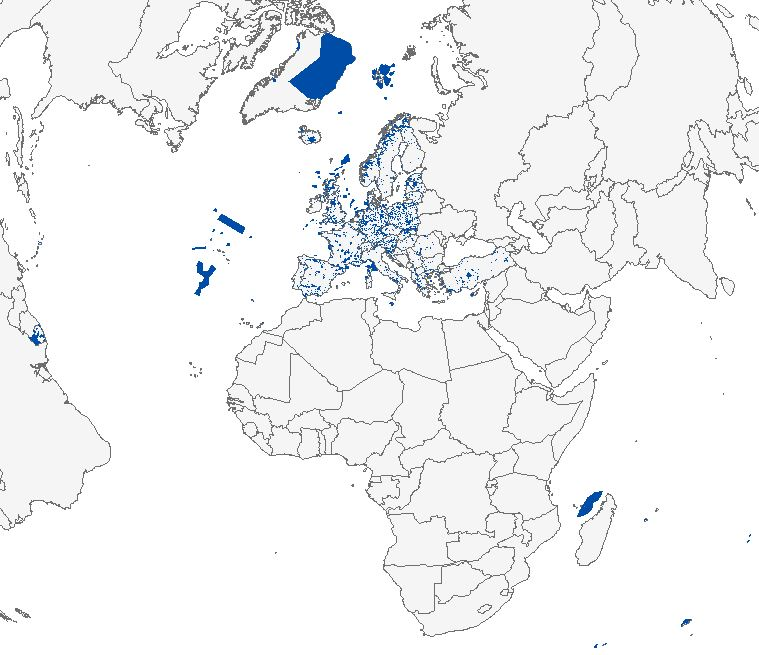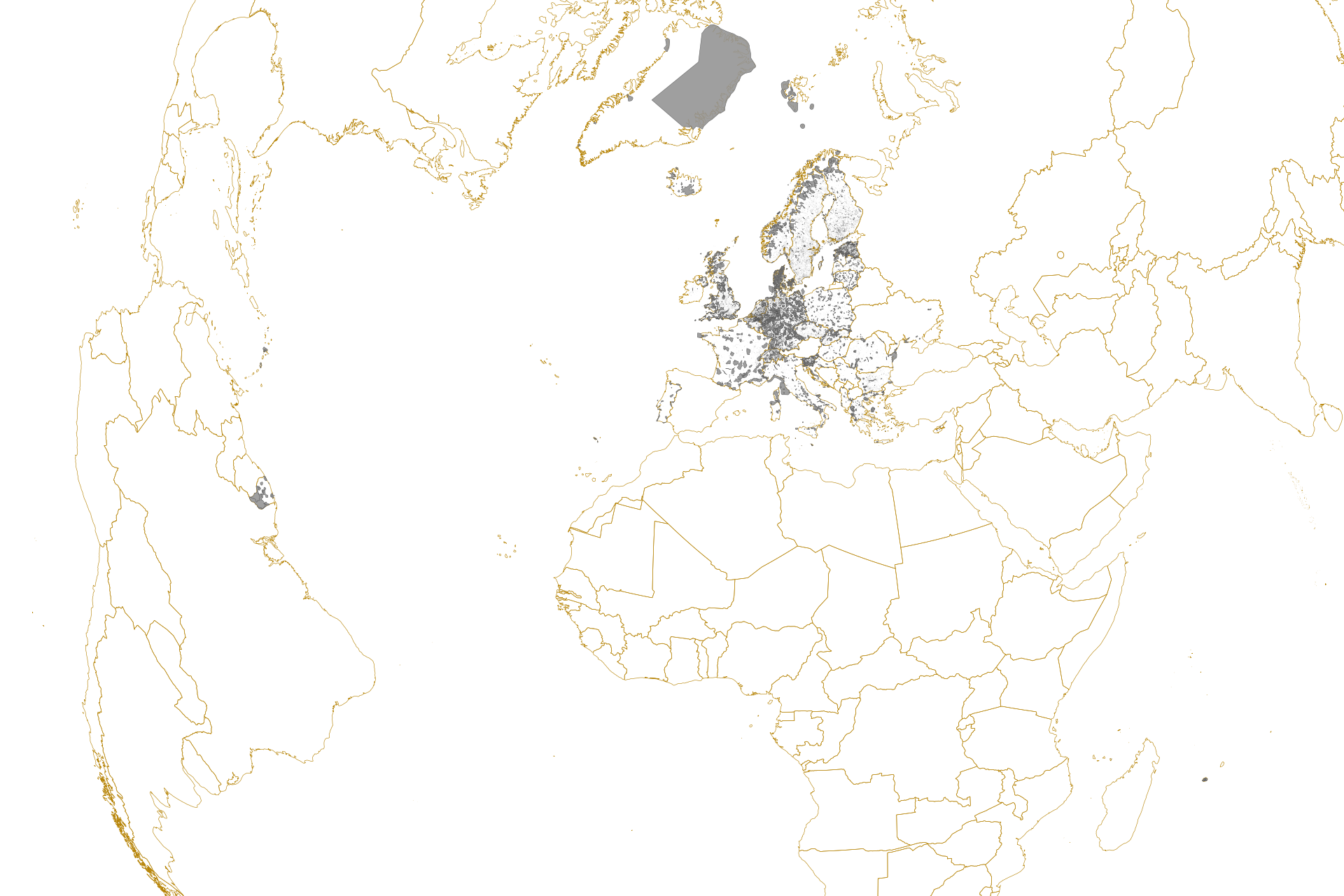protected area
Type of resources
Available actions
Topics
INSPIRE themes
Keywords
Contact for the resource
Provided by
Years
Formats
Representation types
Update frequencies
status
Scale
Resolution
-

The European inventory of nationally designated areas holds information about protected sites and about the national legislative instruments, which directly or indirectly create protected areas.
-

The Common Database on Designated Areas (CDDA) is more commonly known as Nationally designated areas. The inventory began in 1995 under the CORINE programme of the European Commission. It is now one of the agreed Eionet priority data flows maintained by EEA with support from the European Topic Centre on Biological Diversity. It is a result of an annual data flow through Eionet countries. The EEA publishes the data set and makes it available to the World Database of Protected Areas (WDPA) and to Eurostat. The CDDA data can also be queried online in the European Nature Information System (EUNIS). Geographical coverage of GIS vector boundary data: Albania, Austria, Belgium, Bosnia and Herzegovina, Bulgaria, Croatia, Cyprus, Czech Republic, Denmark, Estonia, Great Britain, Greece, Ireland, France, Germany, Iceland, Italy, Kosovo under UNSC Resolution 1244/99, Latvia, Liechtenstein, Lithuania, the North Macedonia, the Netherlands, Norway, Poland, Portugal, Romania, Serbia, Slovakia, Slovenia, Sweden and Switzerland. EEA does not have permission to distribute some or all sites reported by Austria, Estonia, Finland, Hungary, Ireland, Kosovo under UNSC Resolution 1244/99, Malta, the Netherlands, Romania, Slovenia, Spain and Turkey.
-

The European inventory of nationally designated areas holds information about protected sites and about the national legislative instruments, which directly or indirectly create protected areas.
-

The European inventory of nationally designated areas holds information about protected sites and about the national legislative instruments, which directly or indirectly create protected areas.
-

The European inventory of nationally designated areas holds information about protected sites and about the national legislative instruments, which directly or indirectly create protected areas.
-

The Common Database on Designated Areas (CDDA) is more commonly known as Nationally designated areas. It is the official source of protected area information from European countries to the World Database of Protected Areas (WDPA). The inventory began in 1995 under the CORINE programme of the European Commission. It is now one of the agreed Eionet priority data flows maintained by EEA with support from the European Topic Centre on Biological Diversity. The CDDA data can be queried online in the European Nature Information System (EUNIS). Geographical coverage of GIS vector boundary data: Albania, Austria, Belgium, Bosnia and Herzegovina, Bulgaria, Croatia, Cyprus, Czech Republic, Denmark, Estonia, Finland, France, Germany, Greece, Hungary, Iceland, Ireland, Italy, Kosovo under UNSC Resolution 1244/99, Latvia, Liechtenstein, Lithuania, Luxembourg, the North Macedonia, Malta, Montenegro, the Netherlands, Norway, Poland, Portugal, Romania, Serbia, Slovakia, Slovenia, Spain, Sweden, Switzerland and United Kingdom. EEA does not have permission to distribute some or all sites reported by Estonia, Ireland, Romania and Turkey. When re-using the data, copyright is to be mentioned specifically for Estonia and for Finland: "Estonian Environmental Register 01.01.2017; "©Finnish Environment Institute, 2017".
-

The Common Database on Designated Areas (CDDA) is more commonly known as Nationally designated areas. It is the official source of protected area information from European countries to the World Database of Protected Areas (WDPA). The inventory began in 1995 under the CORINE programme of the European Commission. It is now one of the agreed Eionet priority data flows maintained by EEA with support from the European Topic Centre on Biological Diversity. The CDDA data can be queried online in the European Nature Information System (EUNIS). Geographical coverage of GIS vector boundary data: Albania, Austria, Belgium, Bosnia and Herzegovina, Bulgaria, Croatia, Cyprus, Czech Republic, Denmark, Estonia, Finland, France, Germany, Greece, Hungary, Iceland, Ireland, Italy, Kosovo under UNSC Resolution 1244/99, Latvia, Liechtenstein, Lithuania, Luxembourg, the North Macedonia, Malta, Montenegro, the Netherlands, Norway, Poland, Portugal, Romania, Serbia, Slovakia, Slovenia, Spain, Sweden, Switzerland, Turkey and United Kingdom. EEA does not have permission to distribute some or all sites reported by Austria, Estonia, Hungary, Ireland, Romania and Turkey. When re-using the data, copyright is to be mentioned specifically for Estonia and for Finland: "Estonian Environmental Register 01.01.2016; "©Finnish Environment Institute, 2016".
-

This dataset represents the Network of Marine Protected Areas within OSPAR (Convention for the Protection of the marine Environment of the North-East Atlantic). MPAs are understood as areas for which protective, conservation, restorative or precautionary measures have been instituted for the purpose of protecting and conserving species, habitats, ecosystems or ecological processes of the marine environment. ------ Abstract derived from the abstract provided together with the dataset.
-

The European inventory of nationally designated areas holds information about protected sites and about the national legislative instruments, which directly or indirectly create protected areas.
-

This dataset is compiled from data submitted by HELCOM Contracting States. It includes the borders of designated Baltic Sea Protected Areas. The designation is based on the HELCOM Recommendation 15/5 (1994). During 2009-2010 the data was up-dated within a project to analyse the ecological coherence of the HELCOM protected areas network. The current version of the dataset was created updating an older version of the BSPA shape file. New shapes were supplied by the Contracting States. The dataset was created in the scope of the assessment on the ecological coherence of the Baltic Sea MPA networks. Results are published in "HELCOM 2010. Towards an ecologically coherent network of well-managed Marine Protected Areas – Implementation report on the status and ecological coherence of the HELCOM BSPA network. Balt. Sea Environ. Proc. No. 124B".The Attribute "Site ID" has to be used to link the data to the HELCOM BSPA Database.
 RUC Geo-Data catalogue
RUC Geo-Data catalogue